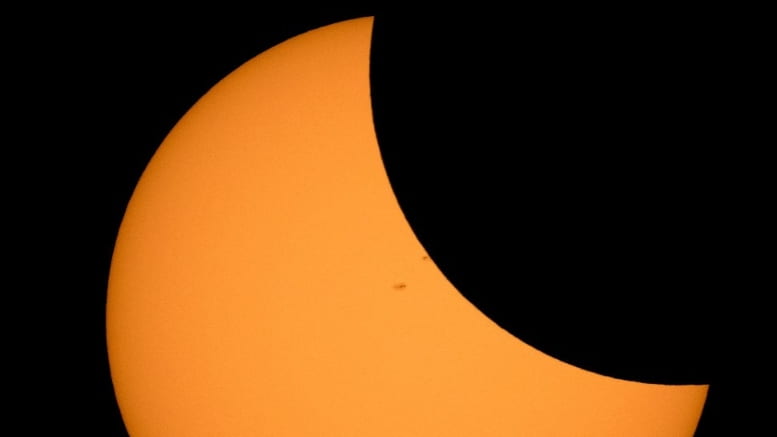On April 8, the much-hyped total solar eclipse arrives, passing across North America. These dramatic celestial spectacles — in which the moon completely blocks out the sun — have long captured attention, shaping history and the way we understand space.
“Historically, [a total solar eclipse] was one of the first ways that we could get information about the outer layers of the sun,” said Michael Smutko, director of the Dearborn Observatory and professor of instruction in physics and astronomy in Northwestern’s Weinberg College of Arts and Sciences.
Nowadays, the rare astronomical phenomenon is still worth seeing, even if you don’t have any scientific studies to conduct. Many people plan to travel to the path of totality, but if you are unable to do so, the Chicago area will still be treated to a partial solar eclipse. Here’s what to know if you’ll be in town on April 8.
What will the eclipse look like in the Chicago area?
At its maximum, 94% of the sun will be covered by the moon as seen from Chicago. Viewers will have more than two hours of eclipse viewing time, with the maximum eclipse coming at 2:07 p.m. Beginning at 12:51 p.m., the moon will start to overlap the sun, making the sun appear more and more like a crescent. The eclipse will end at 3:22 p.m.
“The disc of the moon will slowly creep across, and it’ll look kind of like the phases of the moon,” Smutko said.
At the maximum point, just a tiny sliver of the sun will peek out from behind the moon.
Of course, you’ll only see all of this as the weather permits. “Historically, it’s been cloudy on April 8 two out of three times for the last 20 years,” Smutko said. Still, even if it’s cloudy, the sky will seem darker than normal.
Northwestern will not be hosting a public viewing event, Smutko said, due to astronomers traveling elsewhere to view the eclipse in its totality.
What will it look like in the path of totality?
The eclipse will appear markedly different in the path of totality.
“That extra few percent between 90 and 100, it really does make all the difference,” Smutko said. (Smutko himself plans on being in the Indianapolis area to enjoy the full spectacle.)
During totality, the sun is blocked completely, making it feel as though “night has come early,” Smutko said. Confused by the sudden twilight, birds may stop chirping, while animals like frogs and crickets might begin croaking and chirping like they would at sunset.
It will become dim enough to make out the sun’s corona — the outer atmosphere that is normally outshone by the bright surface of the sun.
“The only time you can observe it without special equipment is during an eclipse like this,” Smutko said.
Do you need eye protection?
Short answer: yes!
“It’s very important that people realize that it is absolutely not safe to view a solar eclipse with unprotected eyes,” Smutko said.
Looking at the sun during the eclipse exposes you to the same dangers of looking at the sun on a regular day without the overwhelming brightness of the sun telling your eyes to look away. Since your retina doesn’t have pain sensors, you can burn it unknowingly, even in just a few seconds.
To avoid this danger, use the proper eye protection (no, sunglasses won’t cut it), and make sure to use an approved filter on any cameras or telescopes used to view the event.
This week, safe solar eclipse glasses and informational handouts are available at no charge during business hours in the physics and astronomy department office (F165, Technological Institute), while supplies last.
If you’re not able to get your hands on eclipse glasses, you can take a page out of Galileo’s book and go old-school with pinhole projection.
“All you need to do is take a piece of cardboard, any thick piece of paper or a piece of aluminum foil and literally put a pinhole through it, no scientific measurements required,” Smutko said.
When light shines through the opening, it will project an image of the sun onto a flat surface, such as the sidewalk, so you can watch the moon pass over it.
Anything with a similar hole will work, even a slotted spoon or a colander, if you want to see lots of tiny eclipses at once.
Why are eclipses so rare?
The moon orbits around the Earth, going through its cycle of phases every 29.5 days. The reason we don’t get an eclipse every month is because the moon’s orbit around the Earth is tipped.
“The moon doesn’t orbit exactly around the equator of the Earth,” Smutko said. “It’s tipped about 5 degrees. So what that means is most of the time, the shadow of the moon just completely misses the Earth.”
Even when the celestial bodies are perfectly aligned, the moon’s shadow on the Earth is very small, making it relatively rare from any one location. Next week, on April 8, the shadow will cover just a narrow strip of the U.S. totally.
“Now, if you could fly all over the world, then you’d be able to see them much more often,” Smutko said.
For those without a jet-setting lifestyle, it’s a waiting game.
What other astronomical events are there to look forward to?
The next easily observable astronomical event for the Chicago area will be next year’s total lunar eclipse on March 13-14, 2025.
If you have a hankering to learn more about the heavens — and their observation — you can stop by Dearborn Observatory every Friday night for free public viewings.
And, of course, you can mark your calendar for the solar eclipse on Sept. 14, 2099, when Evanston and Chicago will both land in the path of totality.

